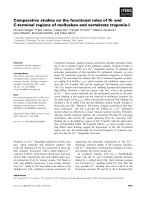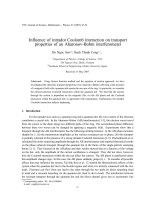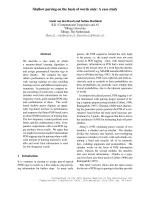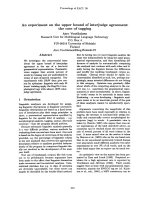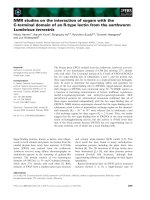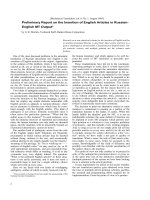Báo cáo " Influence of laser parameters on the stationary operation of a two-mode random micro laser " pdf
Bạn đang xem bản rút gọn của tài liệu. Xem và tải ngay bản đầy đủ của tài liệu tại đây (414.5 KB, 4 trang )
VNU Journal of Science, Mathematics - Physics 23 (2007) 139-142
139
Influence of laser parameters on the stationary operation
of a two-mode random micro laser
Dinh Van Hoang
*
, Mai Hong Hanh
Department of Physics, College of Science, VNU
334 Nguyen Trai, Thanh Xuan, Hanoi, Vietnam
Received 28 May 2007; received in revised form 11 October 2007
Abstract. Solving the system of equations describing the stationary operation of a two-mode
random microlaser we have found the transformation of saturated values of mode intensity when
laser parameters as gain and loss coefficients as well as field coupling, photon hopping
coefficients vary. From obtained results we determined which parameter takes the most important
role for stationary operation of random microlasers.
Keywords: Random microlaser, field coupling.
1.
Introduction
The study of random microlaser has been begun since three decades ago. Random lasing has
been found in ZnO powder [1,2], in solution of TiO
2
nanoparticles, in Rhodamine dye in polymethy-
methacrylate (PMMA) or in some polymer systems [3,4]. Recently, experiments showed random laser
action with sharp lasing peak [5, 6]. The explanation of this has been not done yet.
There are many theoretical models that were established like John et al [7] combining the
electron number equations of energy level with diffusion equation, Berger et al [8] using a Monter
Carlo simulation and recently Kiang et al [9] combining a FDTD method with the semi classical laser
theory [10]. However, at present the research on random laser is concentrated to the steady-state
properties. Therefore, in this paper we examine the stationary operation of two-mode random
microlaser. Starting from basic equations for two-mode random microlaser presented in [11], we have
solved the basic equations in stationary regime by using numerical method.
The obtained results are shown in Section 2. In Section 3, we give the curves describing the
influence of laser parameters on the saturated values of mode intensities and Section 4 devoted to
discussion and conclusion.
2. Basic equations and solving method
In stationary regime, from [11] we have the system of equations:
2
11 11 121 2 212
nn nn n0α−β−θ +γ = (1)
______
*
Corresponding author. E-mail:
D.V. Hoang, M.H. Hanh / VNU Journal of Science, Mathematics - Physics 23 (2007) 139-142
140
2
22 22 2121 121
nn nnn0α−β−θ +γ = (2)
Where
ii
,(i1,2)αγ = denote gain and loss coefficients,
12 21
,
θ
θ - field coupling coefficients,
12 21
,γγ- photon hopping coefficients, n
1
, n
2
- photon densities of mode 1 and 2.
These equations (1), (2) have been solved numerically by the Matlab language with chosen
values of parameters shown in Table 1 (as seen in [12]).
Table 1.
1 1 12 12
2 2 21 21
1.1 0.4 0.8 0.35
0.9 0.3 0.7 0.35
α= β= θ = γ =
α= β= θ = γ =
For studying the influence of laser parameters on saturated values of mode photon densities, we
vary one of parameters in table 1 and remain invariable all the rest of parameters. The obtained results
are shown in Section 3.
3. Influences of laser parameters on saturated photon densities
3.1.Gaincoefficients
i
α
The curves presents in Fig.1 show the transformation of photon densities n
1
, n
2
when
12
,
α
α
vary.
We see that, when the gain coefficient
1
α
augments, the mode photon density
1
n is increased
and the one of mode 2
2
n
is diminished (see Fig 1a). However, when the gain coefficient
2
α
augments, the transformation of photon densities is inverse (see in Fig 1b). This reveals that the
increase of one mode photon density caused in the decrease of the other one.
Fig. 1a. Gain coefficient α
1
varies.
Fig. 1b. Gain coefficient α
2
varies.
D.V. Hoang, M.H. Hanh / VNU Journal of Science, Mathematics - Physics 23 (2007) 139-142
141
3.2.Losscoefficients
i
β
In this case, the augmentation of loss coefficient of one mode will decrease the photon density
of this mode but increase the one of other mode as seen in Fig 2a, 2b.
Fig. 2a. Loss coefficient β
1
varies.
Fig. 2b. Loss coefficient β
2
varies.
3.3.Fieldcouplingcoefficients
i,j
θ
Analogously, the influence of field coupling coefficients
12
θ
and
21
θ
on the photon densities is
inverse (see Fig 3a, 3b). This shows that in the process of interation between the fields of two modes, the
increase of photon density of one mode always results in the decrease of photon density of other mode.
Fig. 3a. Field coupling coefficient θ
12
varies.
Fig. 3b. Field coupling coefficient θ
21
varies.
D.V. Hoang, M.H. Hanh / VNU Journal of Science, Mathematics - Physics 23 (2007) 139-142
142
4.
Discussion and conclusion
In the stationary operation of two-mode random microlaser, the variation of laser parameters
influences clearly on the transformation of mode photon densities. With each parameter, its influence
on two modes almost is inverse. The increase of photon intensity of one mode makes the decrease of
the one of other mode. The reason perhaps is due to the conservation of energy in the operation of
two-mode random microlaser. However, this result reflects the energy transformation and the complex
interaction process inside the laser powder that needs to be investigated thoroughly. We also note that
with a small transformation of loss coefficient, the mode photon density varies clearly and quickly.
Therefore, loss coefficient takes the important role in the process transformating the mode photon
density in random laser that has been indicated in same experiments works (see [5]). At last, we hope
this study method realized here will be extended to the case of multimode random microlaser
afterwards.
Acknowledgements. This work was supported by National Fundamental Science Research Program
under Grant N
0
4.057.06 and by VNU Main Point Subject N
0
QGTD 06-02.
References
[1] Haceketal,Appl.Phys.Lett.vol73(1998)3656.
[2] H.Caoetal,Phys.Rev.Lett.vol82(1999)2278.
[3] H.Caoetal,Phys.Rev.E.vol61(2000)1985.
[4] S.V.Frolovetal,Phys.Rev.B.vol57(1998)9141.
[5] H.Caoetal,Ibid,vol87(2000)5584.
[6] S.V.Frolowetal,Phys.Rev.B.vol59(1999)R5284.
[7] S.Johnetal,Phys.Rev.A.vol54(1996)3642.
[8] G.A.Bergeretal,Phys.Rev.E.vol56(1997)6118.
[9] X.Jiangetal,Phys.Rev.Lett.vol85(2000)70.
[10] C.W.J.Beenaker,Phys.Rev.Lett.vol81(1998)1829.
[11] Dinh Van Hoang, Mai Hong Hanh, Proceeding of Scientific Conference on Occasion 50
th
Anniversary of VNU,
October(2006)65,inHaNoi.
[12] X.Kiangetal,Phys.Rev.B.vol69(2004)104202.
